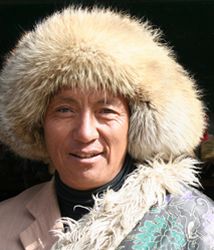Western Jiarongic Profile
Autonyms: (Lavrung): la vruŋ, roŋ; (Daofu): sTau; (Xinlong-Muya): mə ȵa
Other names: (Lavrung): Guanyinqiao, 拉坞戎, 观音桥; (Shangzhai): Puxi, 上寨, 蒲西; (Daofu): 道孚; (Geshiza): Geshitsa, 革什扎; (Xinlong-Muya): Nyagrong-Minyag, 新龙木雅
Heading west from the traditional Situ Jiarong heartland of what is now Ma’erkang County, the Da Jinchuan River effectively represents a linguistic border, beyond which lies the realm of the Western Jiarongic languages, of which there are around 60,000 speakers in total. Though formerly referred to collectively as “Ergong”, these Western Jiarongic speakers do not in fact represent a single, distinguishable language or people group in a comparable way to the Queyu or Jiarong, for example.
The language spoken around Guanyinqiao and along the Sheke River area of Jinchuan and Rangtang Counties is known as “Lavrung”. Further south and west, there remain speakers of at least four distinct yet related Jiarongic languages that may each have further local variations and sub-dialects. There is the Shangzhai language, west of Lavrung in Rangtang County. The Daofu language is spoken along the Xianshui River in southern Luhuo County and much of Daofu County. The Geshiza language is particularly spoken along the valleys of western Danba County. Then, quite recent research by Suzuki(3) has confirmed the whereabouts of around 1000 speakers of Xinlong-Muya – a Jiarongic language, not to be confused with the Muya people and language of Kangding and Jiulong Counties.
In terms of culture, religion and ethnicity, the Western Jiarongic speakers have much in common with the Jiarong. In fact, the most important Tibetan Buddhist monastery for the Jiarong is at Guanyinqiao, and many Jiarong make the pilgrimage there to worship. Like the other Qiangic Tibetan groups, farming is still the main way of life for Western Jiarongic speakers, though increasingly these days the young men leave their communities to find more profitable work as builders or truck drivers in Sichuan’s cities or even further afield. Some families also send their son to the monastery, both to get an education and as an “offering”.


